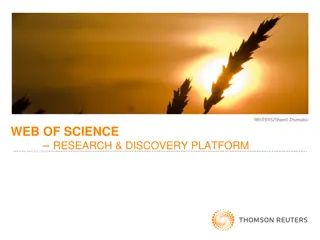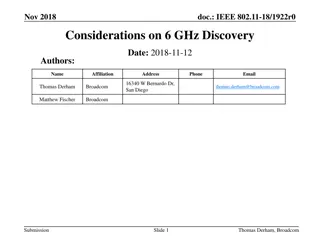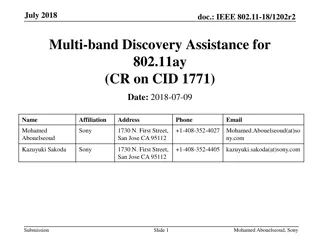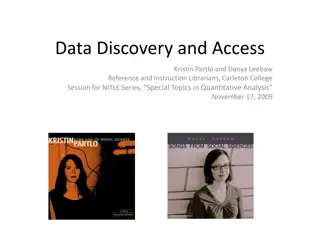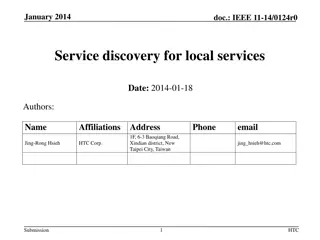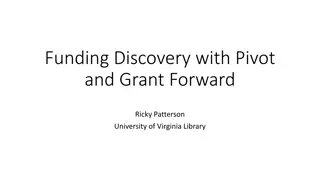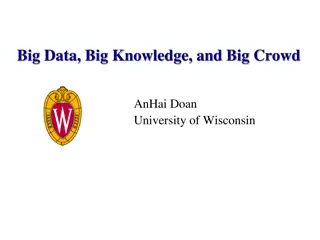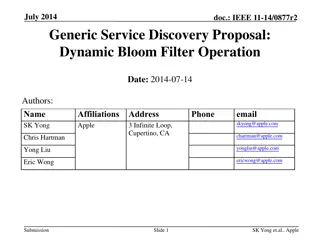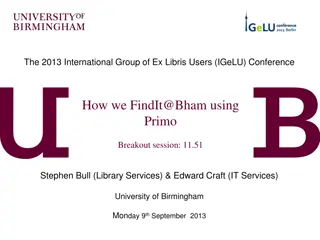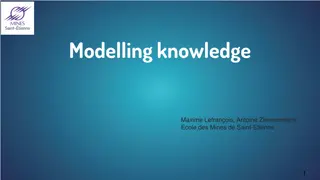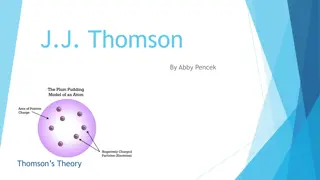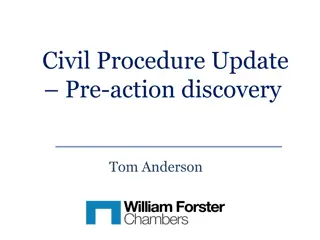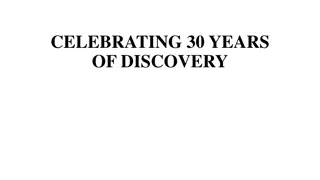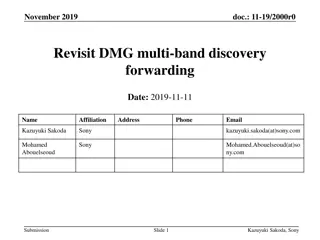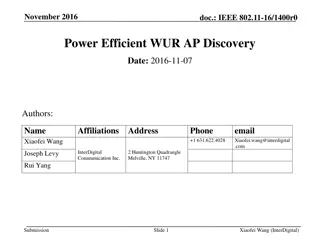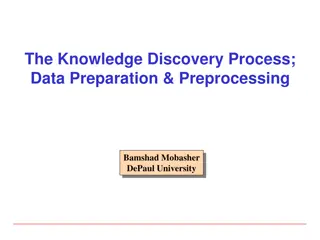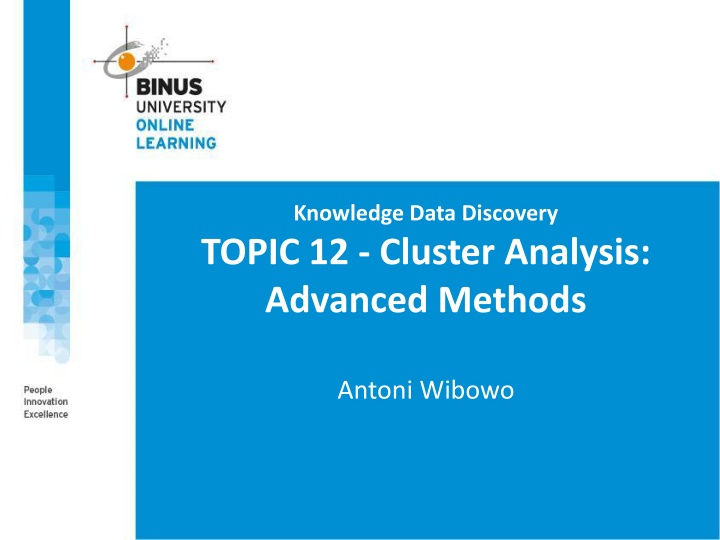
Advanced Cluster Analysis Methods in Data Discovery
Explore advanced methods in cluster analysis with Antoni Wibowo. Learn about model-based clustering, fuzzy clustering, probability-based clustering, self-organizing map, and handling high-dimensional data. Dive into key concepts like fuzzy function modeling and soft versions of K-means clustering for comprehensive data insights.
Download Presentation

Please find below an Image/Link to download the presentation.
The content on the website is provided AS IS for your information and personal use only. It may not be sold, licensed, or shared on other websites without obtaining consent from the author. If you encounter any issues during the download, it is possible that the publisher has removed the file from their server.
You are allowed to download the files provided on this website for personal or commercial use, subject to the condition that they are used lawfully. All files are the property of their respective owners.
The content on the website is provided AS IS for your information and personal use only. It may not be sold, licensed, or shared on other websites without obtaining consent from the author.
E N D
Presentation Transcript
Knowledge Data Discovery TOPIC 12 - Cluster Analysis: Advanced Methods Antoni Wibowo
COURSE OUTLINE 1. MODEL-BASED CLUSTERING CONCEPT 2. FUZZY CLUSTERING: FCM 3. PROBABILITY-BASED CLUSTERING: GAUSSIAN MIXTURE MODELS AND EM ALGORITHM 4. SELF-ORGANIZING MAP (SOM) 5. CLUSTERING HIGH-DIMENSIONAL DATA 6. ISSUES ON CLUSTERING
Note: This slides are based on the additional material provided with the textbook that we use: J. Han, M. Kamber and J. Pei, Data Mining: Concepts and Techniques and P. Tan, M. Steinbach, and V. Kumar "Introduction to Data Mining .
Basic Concepts Fuzzy function to model similarity measures In non-fuzzy or hard clustering discussed so far, data is divided into crisp clusters, where every data object is assigned to exactly one cluster. Fuzzy set theory proposed by Lotfi Zadeh in 1965 gave an idea of uncertainty of belonging which was described by a membership function. In fuzzy clustering, a data point can belong to more than one cluster according to fuzzy membership grades which the data point belong to the different clusters.
Fuzzy Clustering Assume every data object belongs to K cluster according to fuzzy membership as model Soft version of K-means clustering Determine fuzzy membership function Need to find cluster fuzzy membership matrix Learning process is to minimize value of objective function
Fuzzy Clustering (4) 1 0.9 0.8 0.7 0.6 0.5 0.2399 0.6813 0.5901 ... 0.2478 0.6709 0.0603 0.4823 ... 0.9169 0.4 0.3 0.2 0.1 0 0 0.2 0.4 0.6 0.8 x1 x2 x3 x4 x5 x6 x7 x8 x9 x10 x11 K=1 0.9427 0.1096 0.9606 0.0804 0.0915 0.0641 0.7952 0.0316 0.0494 0.1799 0.9637 K=2 0.0573 0.8904 0.0394 0.9196 0.9085 0.9359 0.2048 0.9684 0.9506 0.8201 0.0363
Fuzzy Clustering Algorithms Fuzzy c-Means (FCM) algorithm FCM is better than k-Means algorithm at avoiding local minima, FCM can still converge to local minima of the squared error criterion. Extention of FCM algorithm: Algorithms using an adaptive distance measure: the Gustafson-Kessel algorithm (Gustafson and Kessel, 1979), the fuzzy maximum likelihood estimation algorithm (Gath and Geva, 1989). Algorithms based on hyperplanar or functional prototypes, or prototypes defined by functions: Fuzzy c-varieties (Bezdek, 1981), fuzzy c-elliptotypes (Bezdek, et al., 1981), fuzzy regression models (Hathaway & Bezdek,1993).
The Fuzzy c-Means Algorithm
FCM Algorithm: Learning process data = 0.2399 0.6709 0.6813 0.0603 0.1475 0.8762 0.5872 0.4737 0.5901 0.4823 0.5561 0.1584 0.4088 0.6728 0.5649 0.4232 0.4885 0.2418 0.6513 0.5449 0.2478 0.9169 1 0.9 0.8 0.7 0.6 0.5 0.4 0.3 Objective Function Values 0.7 0.2 0.65 0.1 0.6 0 Objective Function Value 0 0.2 0.4 0.6 0.8 0.55 0.5 0.45 Iteration count = 1, E = 0.667717 Iteration count = 2, E = 0.546202 ... Iteration count = 6, E = 0.284894 Iteration count = 7, E = 0.284786 Iteration count = 8, E = 0.284780 0.4 0.35 0.3 0.25 1 2 3 4 5 6 7 8 9 10 11 Iteration Count
FCM Algorithm: Result 1 0.9 0.8 1 0.7 Clustering 0.9 0.6 0.5 0.8 0.4 0.7 0.3 0.6 0.2 0.5 0.1 0.4 0 0 0.2 0.4 0.6 0.8 0.3 Defuzzyfication: Convert fuzzy membership to crisp clustering 0.2 0.1 0 0 0.2 0.4 0.6 0.8 U matrix x1 x2 x3 x4 x5 x6 x7 x8 x9 x10 x11 K=1 0.9427 0.1096 0.9606 0.0804 0.0915 0.0641 0.7952 0.0316 0.0494 0.1799 0.9637 K=2 0.0573 0.8904 0.0394 0.9196 0.9085 0.9359 0.2048 0.9684 0.9506 0.8201 0.0363
Experiment Results FCM algorithm imposes a spherical shape on the clusters, regardless of the actual data distribu-tion. The dots represent the data points, + are the cluster means. The Gustafson Kessel algorithm can detect clusters of different shape and orientation.
Probabilistic Model-Based Clustering
Probabilistic Model- Based Clustering Probabilistic model-based clustering frameworks assume: A hidden category is a distribution over the data space, which can be mathematically represented using a probability density function. Data has been generated from K probability distributions The data we can described by finding the statistical model that best fits the data. The statistical process involves deciding on a statistical model, e.g. Gaussian Mixture Models, and estimating the distribution parameters of the model from the data EM Algorithm
Mixture Models (1) Mixture models view the data as a set of observations (observed objects) from a mixture of probability distributions independently. Each distribution corresponds to a cluster and the parameters of each distribution provide a description of the corresponding cluster, typically: center ( ) and spread of clusters ( ). Out task: infer a set of M distributions that is mostly likely to generate dataset D using the above data generation process
Gaussian Mixture Models (2) Single Gaussian Mixture of two Gaussians
Gaussian Mixture Models (3) Mixing coefficients Probability density function Gaussian distribution Mixture of three Gaussians
The EM Algorithm In general situation we do not know which points were generated by which distribution. Finding of maximum-likelihood to estimate distribution parameters is a non-linear constrained optimization problem which difficult to solve. EM algorithm is a framework to approach maximum likelihood to estimate distribution parameters. EM Algorithm is an iterative method, each iteration of EM consist of two steps: Expectation (E-step) and Maximization (M-step).
E-Step and M-Step Initial Parameters 4 3 2 1 0 -1 -2 -2 -1 0 1 2 3 4
E-Step and M-Step E-Step M-Step 4 4 3 3 2 2 1 1 0 0 -1 -1 -2 -2 -2 -1 0 1 2 3 4 -2 -1 0 1 2 3 4 Note that some points still have mixed" colour, indicating that they belong with signicant probability to more than one component/cluster.
E-Step and M-Step E-Step M-Step 4 4 3 3 2 2 1 1 0 0 -1 -1 -2 -2 -2 -1 0 1 2 3 4 -2 -1 0 1 2 3 4
E-Step and M-Step E-Step M-Step 4 4 3 3 2 2 1 1 0 0 -1 -1 -2 -2 -2 -1 0 1 2 3 4 -2 -1 0 1 2 3 4 EM algorithm is usefull since a weakness of the k-means is not able to work well when clusters may overlap and may be wider than others.
Advantages and Disadvantages of Mixture Models Strength Mixture models are more general than partitioning and fuzzy clustering Clusters can be characterized by a small number of parameters The results may satisfy the statistical assumptions of the generative models Weakness Converge to local optimal Computationally expensive if the number of distributions is large, or the data set contains very few observed data points Need large data sets Hard to estimate the number of clusters 31
Neural Network Approaches Neural Networks approaches Represent each cluster as an exemplar, acting as a prototype of the cluster New objects are distributed to the cluster whose exemplar is the most similar according to some distance measure Typical methods SOM (Soft-Organizing feature Map) Competitive Learning Involves a hierarchical architecture of several units (neurons) Neurons compete in a winner-takes-all fashion for the object currently being presented 33
Self-Organizing Map (SOM) A self-organizing map (SOM) or self-organizing feature map (SOFM) is clustering and data visualization technique based on a neural networks viewpoint that is trained using competitive learning. SOM is able to map high-dimensional data in a lower dimension, typically two dimension, that makes SOMs useful for visualizing low-dimensional views of high-dimensional data. The 2D map is useful in Identifying clusters Analyzing and discovering pattern in the input space Detecting non-linear correlation between features 34
Self-Organizing Map (SOM) SOMs operate in two modes: training and mapping: Training builds the map using input examples (a competitive process, also called vector quantization), Mapping classifies automatically a new input vector. A SOM consists of nodes or neurons associated with weight vectors of the same dimension as the input data, and a position in the map space. The nodes usually are arranged in a two-dimensional rectangular grid or hexagonal grid lattice. The procedure for placing a vector from data space onto the map is to find the node with the closest weight vector to the data space vector.
SOM: Architecture of the networks SOM Map (6x6) SOM architecture consist in two layers (feed-foreward) Input layer Output layer (competitive) Neurons are arranged in a 2D grid lattice Neighboring relations between neurons Each neuron contains a weight vector w (called also prototype vector or reference vector) N- dimensional weight vector (represent a neuron) N-dimensional input vector (an object)
SOM Learning Process (1) The goal of learning in SOM is to cause different parts of the network to respond similarly to certain input patterns. SOM essential processes: Competition: When an input object is presented to the network, discriminant function is computed for all weight vectors. Neuron with most similar weigh vector to the input object is called the best matching unit (BMU) and the winner of competition. Cooperation: the BMU determines the spatial location of a topological neighborhood of excited neurons, thereby providing the basis for cooperaion among such neighboring neurons. This neighboring will depend on the type of lattice used and neighborhood radius. Adaptation: The last process enable the exited neurons to increase their resemblance to the input pattern through suitable adjustments made to their weight vectors.
SOM Learning Process (2) Adaptation process of weigh vectors to next input vector (data object) input vector winner
Visualization Techniques The U-matrix (unified distance matrix) is a representation of a self-organizing map (SOM) where the Euclidean distance between the weight vectors of neighboring neurons is depicted in a grayscale image. This image is used to visualize the data in a high- dimensional space using a 2D image. In cluster analysis U-Matrix provides a simple way to visualize cluster structure of SOM: For each node in the map, compute the average of the distances between its weight vector and those of its immediate neighbors Average distance is a measure of a node s similarity between it and its neighbors
U-Matrix: an application Information about welfare and poverty-related aspects of 77 countries are treated by the SOM algorithm. The hexagonal grid is a unified distance matrix, commonly known as a U-matrix. Each hexagon represents a node in the SOM. SOM for identification statistical data describing various quality-of-life factors (such as state of health, nutrition, educational services etc.) Countries with similar quality-of-life factors end up clustered together.
Web Document Clustering Using SOM The result of SOM clustering of 12,088 Web articles The picture on the right: drilling down on the keyword mining Based on websom.hut.fi 42
SOM Issues The algorithm is complicated and there are a lot of parameters (such as the learning rate ) - these settings will affect the results The idea of a topology in high dimensional gene expression spaces is not exactly obvious How do we know what topologies are appropriate? In practice people often choose nearly square grids for no particularly good reason As with k-means, we still have to worry about how many clusters to specify
Semi-Supervised Learning Sparsity in data: training examples cannot cover the data space well unlabeled data can help to address sparsity 45
Semi-Supervised Learning Methods Many methods exist: EM with generative mixture models, self- training, co-training, data-based methods, transductive SVM, graph-based methods, Inductive methods and Transductive methods Transductive methods: only label the available unlabeled data not generating a classifier Inductive methods: not only produce labels for unlabeled data, but also generate a classifier Algorithmic methods Classifier-based methods: start from an initial classifier, and iteratively enhance it Data-based methods: find an inherent geometry in the data, and use the geometry to find a good classifier 46
Clustering High- Dimensional Data Clustering high-dimensional data Many applications: text documents, DNA micro-array data Major challenges: Many irrelevant dimensions may mask clusters Distance measure becomes meaningless due to equi-distance Clusters may exist only in some subspaces Methods Subspace-clustering: find clusters in all the possible subspaces CLIQUE, ProClus, and bi-clustering approach Dimensionality reduction approaches: Construct a much lower dimensional space and search for clusters there (may construct new dimensions by combining some dimensions in the original data) Dimensionality reduction methods and spectral clustering
Traditional Distance Measures May Not Be Effective on High-D Data Traditional distance measure could be dominated by noises in many dimensions Ex. Which pairs of customers are more similar? By Euclidean distance, we get, despite Ada and Cathy look more similar Clustering should not only consider dimensions but also attributes (features) Feature transformation: effective if most dimensions are relevant (PCA & SVD useful when features are highly correlated/redundant) Feature selection: useful to find a subspace where the data have nice clusters 49
The Curse of Dimensionality (graphs adapted from Parsons et al. KDD Explorations 2004) Data in only one dimension is relatively packed Adding a dimension stretch the points across that dimension, making them further apart Adding more dimensions will make the points further apart high dimensional data is extremely sparse Distance measure becomes meaningless due to equi-distance 50


